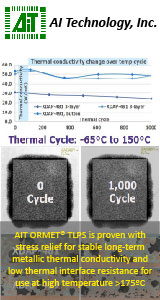|

|
|
| Ask the Experts | |||||||
|
|||||||
|
February 4, 2008 - Updated February 3, 2008 - Originally Posted Lead FloatWe are placing and soldering TSOP-56pin I.C 's. We have done some investigation, checking the component before loading into the SMT machine, as well as checking the solder applied on all pins. We continue to have the problem. Why and how does lead float occur? G. H. |
|||||||
| Expert Panel Responses | |||||||
|
Due to the light weight of these components and the surface tension of the solder this may be causing the components to float out of alignment during reflow. I would also look for some type of vibration occurring as the PCB is moved thru the reflow oven OR a cooling fan blowing the part out of alignment. Try the following: Rotate the PCB 90 or 180 degrees on the oven belt or conveyor to see if it is caused by a cooling fan. Check the components leads for oxidation that is preventing the solder from wetting to the leads. If this doesn't help try a gluing operation to secure the TSOP in place or reduce the solder volume in the TSOP locations.
Regional Sales Manager OK International Inc. Ed Zamborsky is a Regional Sales & Technical Support Manager for Thermaltronics, located in New York. His position requires frequent customer visits throughout North America and the Caribbean and his position encompasses not only sales but the role of trainer and master applications engineer for all of Thermaltronics products. His expertise includes such specialties as hand soldering, convection and conduction reflow techniques, array rework, fluid dispensing equipment, and fume extraction. Ed has authored many articles and has presented many papers on topics such as; Low Volume SMT Assembly, Solder Fume Extraction, SMT Rework, BGA Rework, Lead-Free Hand Soldering, High Thermal Demand Hand Soldering, Lead Free Visual Inspection and Lead Free Array Rework.
There could be a variety of reasons for this particular condition to occur with this particular type of component. There is no mention made of the lead plating material, the type of solder paste used and the loading of the solder paste flux in the question and all of these parameters must be taken into consideration when trying to figure out this problem. Basically the component floats because the surface area of the leads overcomes the weight of the component, the same as a ship floats on the water, it displaces its own weight. The temperature of the profile, the z axis placement force should all work together to heat the leads, allowing the flux from the paste to reduce the surface tension on the leads thereby allowing the solder to wet the leads and pull the component down into the molten solder. There are many other issues to consider and I would be willing to discuss this if you get in touch with me.
Vice President, Technical Director EPTAC Corporation At EPTAC Corporation, Mr. Lambert oversees content of course offerings, IPC Certification programs and provides customers with expert consultation in electronics manufacturing, including RoHS/WEEE and lead free issues. Leo is also the IPC General Chairman for the Assembly/Joining Process Committee.
How big is the die in the TSOP? A number of companies are reporting issues with this kind of behavior with Alloy 42 TSOPs with large die, especially on bigger, thicker boards with more copper.
CEO & Managing Partner DfR Solutions Dr. Hillman's specialties include best practices in Design for Reliability, strategies for transitioning to Pb-free, supplier qualification, passive component technology and printed board failure mechanisms.
|
|||||||
| Submit A Comment | |||||||
|
Comments are reviewed prior to posting. You must include your full name to have your comments posted. We will not post your email address. |
|
Free Newsletter Subscription
Circuitnet is built for professionals who bear the responsibility of looking ahead, imagining the future, and preparing for it. Insert Your Email Address |
|

|





